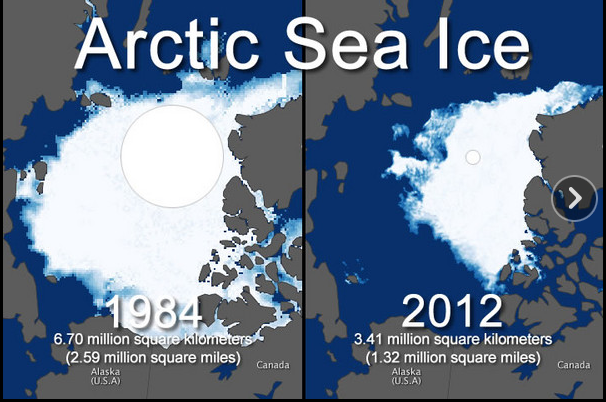 Despite all my crying and slobbering, it’s Monday again!
Despite all my crying and slobbering, it’s Monday again!
And this early morning finds itself clear and cold on California’s north coast — weather better than most.
One big climate question answered: Two university scientists have found that the “pause” or “hiatus” in global temperatures can be largely explained by a failure of climate researchers to record the dramatic rise in Arctic temperatures over the past decade or more.
(Illustration found here).
And does any of this come into play as per this weekend’s horrific tornado onslaught through the US midsection? Six people have been killed, at last count, after 81 reported tornadoes slapped the Midwest, one of those an EF4 tornado packing a peak wind of 166 mph, tore the shit out of Washington County, Illinois:
“It was complete destruction,” said resident Anthony Khoury. “There are people in the streets crying.”
As the dark twister churned toward his home, Khoury kept his camera glued to the window — and prayed. “Our father, thou art in Heaven, hallowed be thy name.”
“The tornado happened in my backyard, and you can hear people screaming,” Khoury told CNN’s iReport.
“We were freaking out.”
Dr. Jeff Masters at Wunderblog: It’s been an unusually slow severe weather season, with the 2013 preliminary tally of 818 tornadoes the lowest year-to-date count since the extreme drought year of 1988. However, when severe weather outbreaks have come, they have been unusually destructive…November is a highly unusual time to be getting a dangerous severe weather outbreak, but people need to take this event seriously. The four previous November “High Risk” events (1989, 1994, 2002, and 2005) have resulted in a total of 148 tornadoes and 62 fatalities
Although climate scientists can’t 100 percent nail down global warming’s effect on tornadoes — mainly because of wind shear, temperatures in the air, etc., but hotter temps don’t help, and accordingly like a lot of other issues in this circle, no one really know for sure what’s happening.
Even among climate people, especially in the so-called “pause” in rising temperatures. Before this Arctic temperature business, most knowledgable folks claimed the heat was going into the oceans. Now another angle.
From the UK’s Independent:
A new study has found that global temperatures have not flat-lined over the past 15 years, as weather station records have been suggesting, but have in fact continued to rise as fast as previous decades, during which we have seen an unprecedented acceleration in global warming.
…
When Kevin Cowtan of York University and Robert Way of Ottawa University found a way of estimating Arctic temperatures from satellite readings, the so-called pause effectively disappeared and the global warming signal returned as strong as before.
The paucity of surface-temperature records in the remote and inaccessible Arctic has long been recognised as a problem for global estimates, not least by the Met Office itself.
However, the scale of the Arctic warming highlighted by Mr Cowtan and Mr Way has surprised seasoned climate researchers.
“The problem with the polar areas lacking data coverage has been known for a long time, but I think this study has basically solved it,” said Stefan Rahmstorf of the Potsdam Institute for Climate Impact Research in Germany.
He added: “People will argue about the details, as is normal in science, but I think basically this will hold up to scrutiny.”
And what of the UN climate talks now going on in Warsaw, Poland? Anything?
Beyond the old kicking-the-can-down-the-road routine.
Via Climate News Network:
The leader of China’s climate negotiating team at the talks, Su Wei, says he is “not sure whether we are able to make much progress.”
Having said he should “keep silent for a while” over Japan’s reduction in its efforts to cut its emissions of carbon dioxide, Su said: “I don’t know how to describe the meetings and negotiations here in Warsaw.”
But he said the European Union’s targets for reducing greenhouse gas emissions were “not at all ambitious”.
Nor did he accept any responsibility for events which many believe are connected to climate change.
Asked what linked Typhoon Haiyan and China’s growing carbon emissions, he said historic and accumulated carbon concentrations in the atmosphere should be blamed for the disaster.
Though China is one of the world’s biggest carbon emitters, he said: “We are below or around the world’s average in terms of emissions per capita and historical accumulations.
“In spite of this, we have made great efforts to transform our development patterns and decrease the carbon intensity of our economic output.”
Bullshit, and we’re back to square-one.
And it’s still Monday!
(Illustration out front found here).